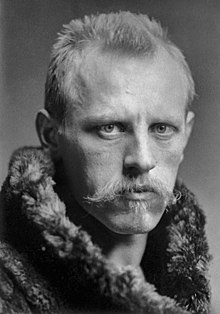
Back Fridtjof Nansen AF فريتيوف نانسين Arabic فريتيوف نانسين ARZ Fridtjof Nansen AVK Frityof Nansen AZ Фритьоф Нансен BA Фрыцьёф Нансен BE Фрыт’яф Нансэн BE-X-OLD Фритьоф Нансен Bulgarian ফ্রিদতিয়ফ নানসেন Bengali/Bangla
Fridtjof Nansen | |
|---|---|
 Nansen in 1890 | |
| Born | 10 October 1861 Store Frøen, Christiania, Norway |
| Died | 13 May 1930 (aged 68) Polhøgda, Lysaker, Norway |
| Education | Royal Frederick University |
| Occupations |
|
| Known for | |
| Spouses |
|
| Children | 5, including Odd |
| Relatives |
|
| Awards |
|
| Signature | |
Fridtjof Wedel-Jarlsberg Nansen (Norwegian: [ˈfrɪ̂tːjɔf ˈnɑ̀nsn̩]; 10 October 1861 – 13 May 1930) was a Norwegian polymath and Nobel Peace Prize laureate. He gained prominence at various points in his life as an explorer, scientist, diplomat, humanitarian and co-founded the Fatherland League.
He led the team that made the first crossing of the Greenland interior in 1888, traversing the island on cross-country skis. He won international fame after reaching a record northern latitude of 86°14′ during his Fram expedition of 1893–1896. Although he retired from exploration after his return to Norway, his techniques of polar travel and his innovations in equipment and clothing influenced a generation of subsequent Arctic and Antarctic expeditions. He was elected an International Member of the American Philosophical Society in 1897.[1]
Nansen studied zoology at the Royal Frederick University in Christiania and later worked as a curator at the University Museum of Bergen where his research on the central nervous system of lower marine creatures earned him a doctorate and helped establish neuron doctrine. Later, neuroscientist Santiago Ramón y Cajal won the 1906 Nobel Prize in Medicine for his research on the same subject.[2] After 1896 his main scientific interest switched to oceanography; in the course of his research he made many scientific cruises, mainly in the North Atlantic, and contributed to the development of modern oceanographic equipment.
As one of his country's leading citizens, in 1905 Nansen spoke out for ending Norway's union with Sweden, and was instrumental in persuading Prince Carl of Denmark to accept the throne of the newly independent Norway. Between 1906 and 1908, he served as the Norwegian representative in London, where he helped negotiate the Integrity Treaty that guaranteed Norway's independent status.
In the final decade of his life, Nansen devoted himself primarily to the League of Nations, following his appointment in 1921 as the League's High Commissioner for Refugees. In 1922 he was awarded the Nobel Peace Prize for his work on behalf of the displaced victims of World War I and related conflicts. Among the initiatives he introduced was the "Nansen passport" for stateless persons, a certificate that used to be recognized by more than 50 countries. He worked on behalf of refugees alongside Vidkun Quisling until his sudden death in 1930, after which the League established the Nansen International Office for Refugees to ensure that his work continued. This office received the Nobel Peace Prize in 1938. His name is commemorated in numerous geographical features, particularly in the polar regions.
- ^ "APS Member History". search.amphilsoc.org. Retrieved 20 February 2024.
- ^ J. S. Edwards & R. Huntford (1998). "Fridtjof Nansen: from the neuron to the North Polar Sea". Endeavour. 22 (2): 76–80. doi:10.1016/s0160-9327(98)01118-1. PMID 9719772.